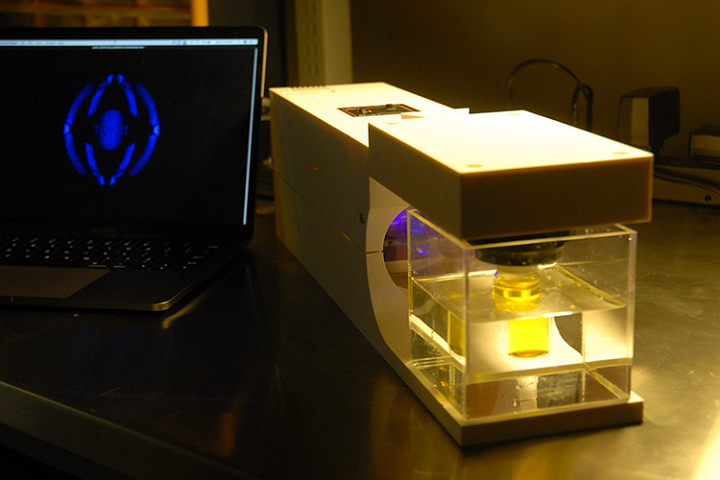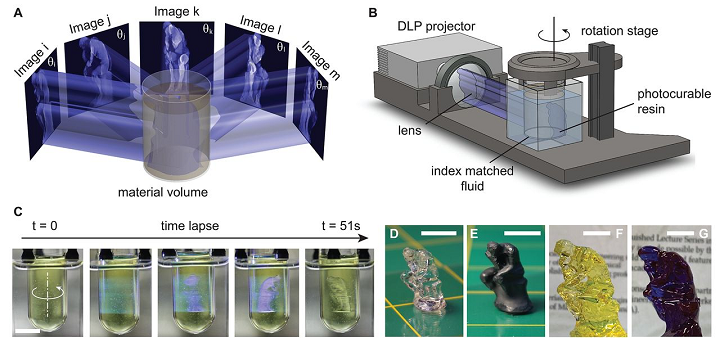It’s been said that volumetric 3D printing has more speed, flexibility, and geometric versatility than other methods, with a lower cost. In late 2017, researchers at Lawrence Livermore National Laboratory (LLNL) in California teamed up with collaborators from MIT, the University of Rochester, and UC Berkeley to develop this method, which flashes laser-generated, hologram-like 3D images into photosensitive resin.
 It seems this collaborative work has continued, since a team of researchers from LLNL and UC Berkeley just published another paper about volumetric 3D printing, titled “Volumetric additive manufacturing via tomographic reconstruction.” Co-authors of the paper are Brett E. Kelly, Indrasen Bhattacharya, Hossein Heidari, Maxim Shusteff, Christopher M. Spadaccini, and Hayden K. Taylor. This has overexcited a lot of press into miraculous claims for the nascent technology.
It seems this collaborative work has continued, since a team of researchers from LLNL and UC Berkeley just published another paper about volumetric 3D printing, titled “Volumetric additive manufacturing via tomographic reconstruction.” Co-authors of the paper are Brett E. Kelly, Indrasen Bhattacharya, Hossein Heidari, Maxim Shusteff, Christopher M. Spadaccini, and Hayden K. Taylor. This has overexcited a lot of press into miraculous claims for the nascent technology.
“This is the first case where we don’t need to build up custom 3D parts layer by layer. It makes 3D printing truly three-dimensional,” explained Kelly, who completed research on the project while a graduate student working jointly at UC Berkeley and LLNL.
The team nicknamed its new 3D printer ‘the Replicator,’ after the fictional Star Trek device that’s able to materialize any object at the push of a button, and filed a patent application on their method.
Jeremy Thomas, a spokesman for LLNL, said, “It looks like something you might find aboard the Starship Enterprise.
“Though it seems like science fiction, it’s not, thanks to scientists and engineers at LLNL and UC Berkeley, who have developed a brand-new high-speed 3D printing method called Computed Axial Lithography (CAL).”
Thomas is referring to a projector that beams a 3D video into a container of viscous, gooey photosensitive resin, which briefly rotates and then lets the fluids drain, leaving behind a complete, fully formed 3D object in minutes. A rotating cylinder of the material reacts to a certain threshold of projected light, which can be crafted into various patterns, to quickly form a solid shape…no layering required.
“Basically, you’ve got an off-the-shelf video projector, which I literally brought in from home, and then you plug it into a laptop and use it to project a series of computed images, while a motor turns a cylinder that has a 3D-printing resin in it. Obviously there are a lot of subtleties to it — how you formulate the resin, and, above all, how you compute the images that are going to be projected, but the barrier to creating a very simple version of this tool is not that high,” explained Taylor, assistant professor of mechanical engineering at UC Berkeley.
The new 3D printer is able to make smoother, more complex, and flexible objects, and can also be used to encase another object with a different material, like putting a handle around the shaft of a metal screwdriver…bringing mass customization further into the realm of possibility.

The 3D printer works by shining changing patterns of light through a rotating vial of liquid. A computer algorithm calculates the exact patterns of light needed to shape a specific object.
Taylor said, “I think this is a route to being able to mass-customize objects even more, whether they are prosthetics or running shoes.
“The fact that you could take a metallic component or something from another manufacturing process and add on customizable geometry, I think that may change the way products are designed.”
CT scans, which project X-rays or electromagnetic radiation into the body from various angles, actually inspired this method, as those patterns of transmitted energy need to be analyzed in order to reveal the geometry of an object, like a tumor.
“Essentially we reversed that principle. We are trying to create an object rather than measure an object, but actually a lot of the underlying theory that enables us to do this can be translated from the theory that underlies computed tomography,” Taylor explained.
 In addition to completing complex calculations to perfect the exact intensities and shapes of various light patterns, the team also had to determine how to develop a material that would stay liquid when exposed to a small amount of light, but would react and form a solid when exposed to a significant amount.
In addition to completing complex calculations to perfect the exact intensities and shapes of various light patterns, the team also had to determine how to develop a material that would stay liquid when exposed to a small amount of light, but would react and form a solid when exposed to a significant amount.
Taylor said, “The liquid that you don’t want to cure is certainly having rays of light pass through it, so there needs to be a threshold of light exposure for this transition from liquid to solid.”
The resulting resin is made up liquid polymers, mixed with photosensitive molecules and dissolved oxygen. The molecules are activated by light, which drains the oxygen, and only in the 3D regions that have been depleted of oxygen will the polymers from cross-links turn the liquid resin into a solid.
The team can also 3D print objects that appear opaque with a dye that transmits light at the curing wavelength, but will absorb most others.
“This is particularly satisfying for me, because it creates a new framework of volumetric or ‘all-at-once’ 3D printing that we have begun to establish over the recent years. We hope this will open the way for many other researchers to explore this exciting technology area,” LLNL staff engineer Shusteff said.
 Additionally, unused resin can be recycled by heating it up in an oxygen atmosphere.
Additionally, unused resin can be recycled by heating it up in an oxygen atmosphere.
Heidari, a graduate student in Taylor’s lab at UC Berkeley, said, “Our technique generates almost no material waste and the uncured material is 100 percent reusable. This is another advantage that comes with support-free 3D printing.”
The researchers created many objects, like a customized jawbone model and a tiny model of Rodin’s “The Thinker” statue, to test out their 3D printer.
While this is definitely an exciting development, it’s important to note that further engineering and polymer chemistry need to be completed in order to improve the resin properties, so more stable structures can be fabricated. In addition, the LLNL and UC Berkeley team can only 3D print objects up to four inches in diameter at the moment, so large-scale objects are off the table right now. Our take is that this is indeed an interesting technology on whose development we’ve been reporting for two years now. But, this is still very much a lab technology that is not close to being commercialized at the moment. A good development and a good thing for 3D printing but it remains to be seen how long it will take to commercialize this properly and then how it will perform. Media tend to forget that 3D printing is a manufacturing technology and therefore will need to work on the concrete floor not just in the press release.
Discuss this research and other 3D printing topics at 3DPrintBoard.com or share your thoughts below.
Subscribe to Our Email Newsletter
Stay up-to-date on all the latest news from the 3D printing industry and receive information and offers from third party vendors.
Print Services
Upload your 3D Models and get them printed quickly and efficiently.
You May Also Like
3D Printing News Briefs, July 2, 2025: Copper Alloys, Defense Manufacturing, & More
We’re starting off with metals in today’s 3D Printing News Briefs, as Farsoon has unveiled a large-scale AM solution for copper alloys, and Meltio used its wire-laser metal solution to...
Etsy Design Rule Change Reduces Selection of 3D Printed Goods
Online marketplace Etsy has implemented a rule change requiring all 3D printed goods on the site to be original designs. The update to the site’s Creativity Standards states, ¨Items produced using...
Siraya Tech Introduces New Elastomer 3D Printing Materials, Including Foaming TPU
California company Siraya Tech, founded in 2019 with a focus on material science, customer focus, and agility, develops high-quality 3D printing materials that meet the needs of creators, hobbyists, and...
3D Printing News Briefs, April 12, 2025: RAPID Roundup
The news from last week’s RAPID+TCT in Detroit just keeps on coming! That’s why today’s 3D Printing News Briefs is another RAPID Roundup of more exciting announcements from the trade...



































